3. At
other times of the year the 'arms' are
bent as
this sequence of glyphs illustrates:
 |
 |
 |
 |
 |
 |
|
Aa1-5 |
Aa1-6 |
Aa1-7 |
Aa1-8 |
Aa1-9 |
Aa1-10 |
| ko te
moa |
e noho ana ki te
moa |
e
moa te erueru |
e
moa te kapakapa |
e
moa te herehua |
ka hora ka tetea |
The 4 'moa' in Aa1-5--8 do not primarily refer to the 'arms' at the
equinoxes and solstices (although they probably allude to them). Instead, they indicate how four
strong 'spring arms' quickly are hoisting the sky roof up. At
summer solstice the 'house' must stand ready.
The 'elbow' is at left in these four 'moa',
but in the following two glyphs the 'joint'
is shifted to the right, as seen in Aa1-9--10. Presumably the other
'arm' comes in as a support beyond midsummer. In ancient Egypt the
sun was sometimes illustrated as a circle being uplifted by the
goddess of the horizon in the east:
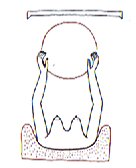
(Ref.: Wilkinson)
The 'moa' are not really fowl but promising young lads according to Barthel 2.
A serpent can easily bend anywhere, an arm or leg only at the
joints. But with joints and stiff bones work can be done, something
OgotemmÍli has explained
"... During his descent the
ancestor still possessed the quality of a water spirit, and his
body, though preserving its human appearance, owing to its being
that of a regenerated man, was equipped with four flexible limbs
like serpents after the pattern of the arms of the Great Nummo.
The ground was rapidly
approaching. The ancestor was still standing, his arms in front of
him and the hammer and anvil hanging across his limbs. The shock of
his final impact on the earth when he came to the end of the
rainbow, scattered in a cloud of dust the animals, vegetables and
men disposed on the steps.
When calm was restored,
the smith was still on the roof, standing erect facing towards the
north, his tools still in the same position. But in the shock of
landing the hammer and the anvil had broken his arms and legs at the
level of elbows and knees, which he did not have before. He thus
acquired the joints proper to the new human form, which was to
spread over the earth and to devote itself to toil." (OgotemmÍli)
|
In winter water is everywhere and, presumably, hakaturou glyphs cannot have any joints. At spring equinox they aquire 'knees'. The ecliptic snake defines the surface of the water.
He has two heads, one in each end. Both heads have their faces upward, meaning living, as seen in this picture of Na-T'e-K'an, 'the Foliated Cross', (from Maya Cosmos):
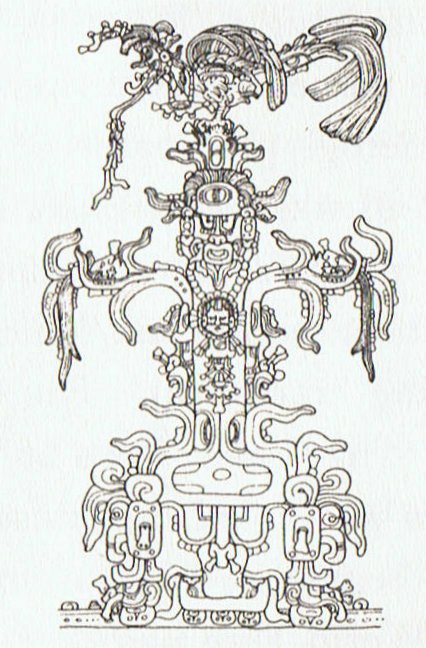
I imagine the
cross-piece is the ecliptic serpent - there are not two entities going
horizontally across the stem in the World Tree.
Furthermore, I extend the series of pages from the link 'te pito o te henua' with a new final page:
The features of
hakaturou glyphs are not so many - no arms and no real
legs, only a head of sorts and a body which can be straight or
curved (with or without a 'knee'). How the head and its jaw is
designed carries meaning, though:
In Ca8-28 the jaw is defined by two straight lines (like a
wedge) and the head is looking backwards, not up as in Bb6-17
and in 'Sunday'. Presumably this is a sign referring to the back
side of the month (descending moon). Ca8-29 has a jaw formed not
so different from that in 'Monday-Wednesday'. Possibly this type
of jaw means 'waxing'.
 |
 |
 |
 |
 |
|
Ca8-28 |
Ca8-29 |
Bb6-17 |
Eb8-25 |
Ab8-84 |
But then, in Bb6-17 the middle 'person' will be the waxing new
year and the one at right (with flames at the back of his head)
will be the old year. The old 'person' should be looking
backwards. And the 2nd half of the 'week' is the old part. Both
examples having non-waxing jaws.
In Eb8-25 the old one is at
left (as in Ca8-28) and the new one at right (as in Ca8-29), the
more natural order. In Bb6-17 this natural order is disturbed by
having a triplet instead of a duo. The triplet forces the
central figure (waxing) to the center.
The growing jaw is at right (as it should) in Ab8-84. Also the
two 'legs' at right exhibit the same growing shape, especially
the top one.
|
There is another possible explanation
of why the mauga has the special type of upwards pointing jaw (in
addition to the jaw of the shark being up during winter), viz. the concept of a
split turtle shell out of which the new will emerge. But we must return to the
pages of the dictionary to let the new idea come in its proper order:
"... (It) was made proper,
the Raised-up-Sky-Place, the Eight-House-Partitions, (is) its
holy name, the house of the north'. In this way we learn that
First Father's 'entering the sky' also created a house in the
north and that it was made of eight partitions. The name of that
house, 'Raised-up-Sky', is the reciprocal opposite of the
'Lying-down-Sky' of the 4 Ahaw 8 Kumk'u place.
'Raised-up-Sky' (Wakah-Chan)
is also the name of the World Tree at the center of the panel in
the Temple of the Cross.
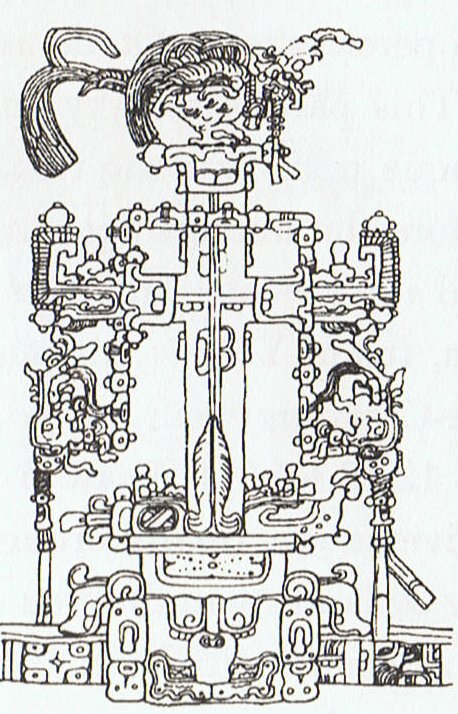
Moreover, the image of
this primordial tree rises out of the original offering plate of
sacrifice. Thus we know that the Maya thought of the entire
north direction as a house erected at Creation with the World
Tree, the Wakah-Chan, penetrating its central axis. First Father
'entered the sky' by raising this tree out of a plate of
sacrifice."
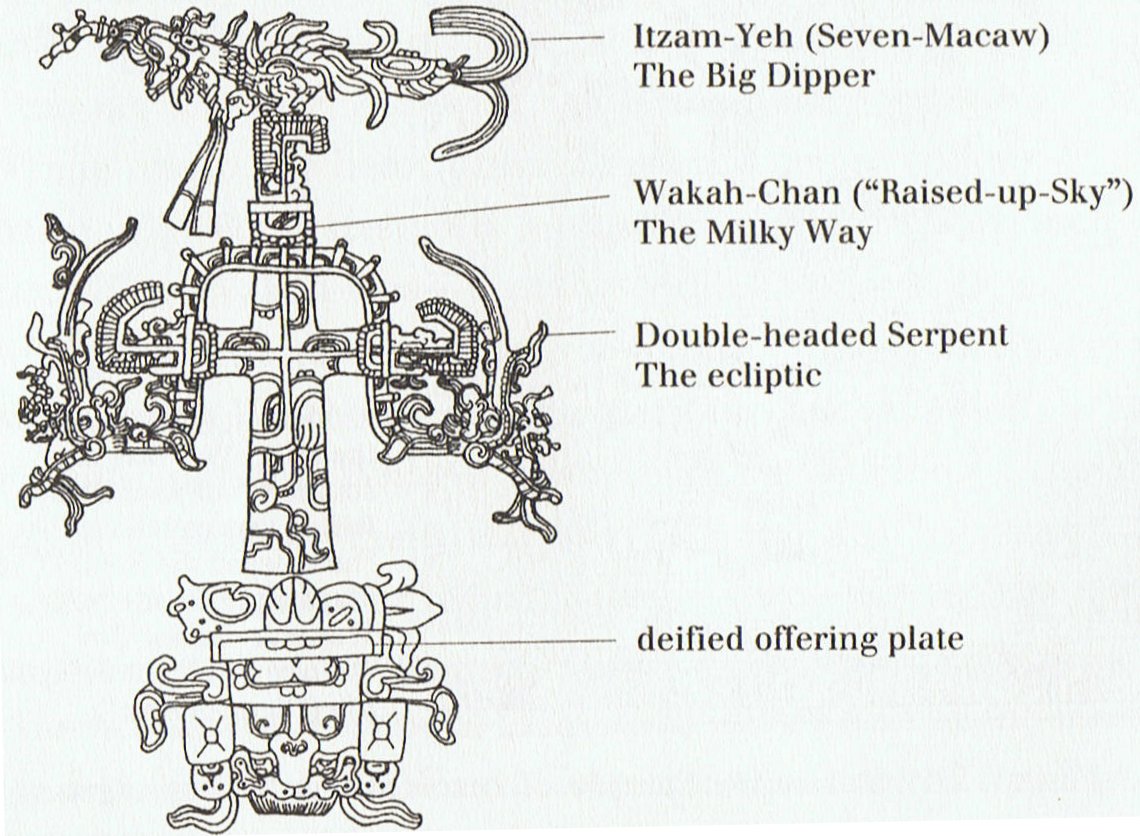
"I thought about the image
of the World Tree and realized that the Double-headed Serpent
that was draped around and through its branches had to be the
ecliptic."
|
The Maya house was in the north. On
Easter Island, at midsummer, a new sky house will be ready, according to what I
read between the lines of the myths. The midsummer sky house, the roof of which
is raised high during spring, probably is not located in the cold and dark south
(toga).
"In the Popol Vuh,
First Father was killed in Xibalba, the Maya Otherworld,
by the Lords of Death. They then buried his body in a ballcourt.
His twin sons went to Xibalba, defeated his killers, and
brought him back to life.

Classic-period artists
depicted First Father being reborn thorugh the cracked carapace
of a turtle shell, often flanked by his two sons."
|
The turtle has a shell and so has the
egg. Ta'aroa broke open his shell (Rumia) at the very beginning
(in the dark).
 |
 |
|
Bb6-17 |
Bb7-25 |
But Ta'aroa was alone, there
was nobody there before him. Therefore Bb6-17 cannot depict him (at least not in
the central position).
Although an egg is the natural symbol
for the very beginning, it is more strange to find a picture of a mountain (mauga)
with an open mouth (cleft) at its top.
However, if we think of volcanoes it
does no longer seem so strange. Often fire will arrive at the top end, on its
way it looks, to reach for the sky. There must be a circulation also in the
flames of the sun. He must 'eat'.
In Maya Cosmos the idea of a mountain
with a cleft is traced back to the time of the Olmecs:
"The Olmec at La Venta
built an effigy volcano at the southern end of the set of buildings known today
as Complex A. They used local clay to create a huge earthen pyramid and fluted
its sides to make it resemble a volcano.
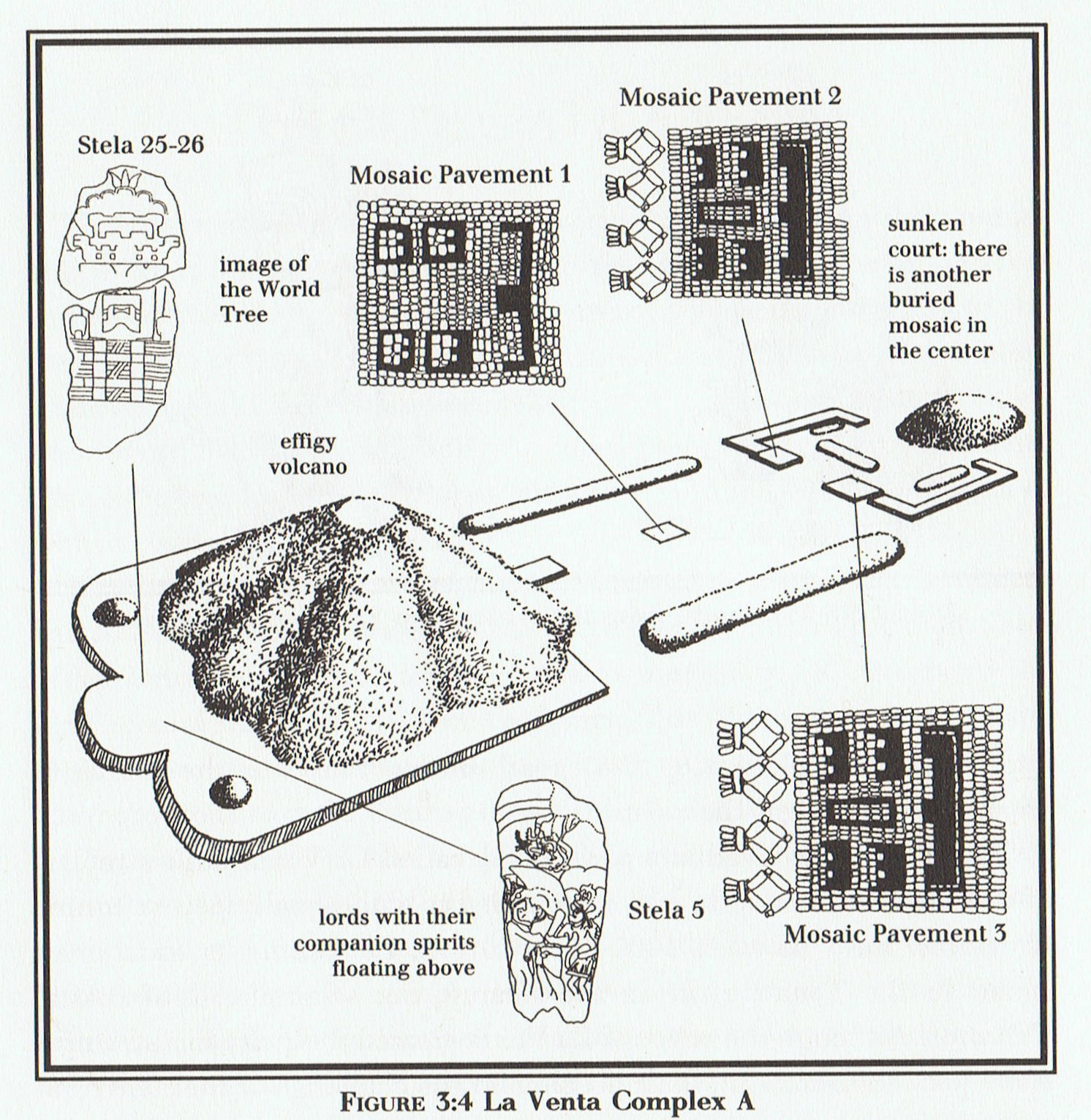
But the La Venta
pyramid was not just a replica of a volcano, it was intended to echo the
mountains made by gods and to show that a similar thing could be made by human
hands.
It was a fiery portal
to the Otherworld, harnessed to the will of living kings. The Maya who came
after also built their pyramids to resemble sacred mountains and called them by
that name." (Maya Cosmos)










